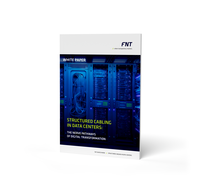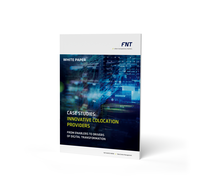
What is Data Center Infrastructure Management?
Data Center Infrastructure Management (DCIM) describes a set of tools or solutions that help manage and optimize the data center infrastructure. DCIM provides a centralized system for monitoring, measuring and managing data center resources, which typically include IT equipment, power, cooling and floor space. The goal is to improve efficiency, reduce costs and increase overall performance by providing insight into the utilization and condition of the various components within a data center. This includes servers, storage devices, network equipment, power distribution units, cooling systems and much more.
DCIM solutions typically offer features such as real-time monitoring, capacity planning, asset management, energy management and reporting. They play a crucial role in the smooth operation of data centers and the optimization of resource utilization.
Main components of Data Center Infrastructure Management
Managing servers, storage systems, network components, virtual machines, and other IT resources within the data center.
Monitoring and optimizing energy consumption in the data center to reduce costs and environmental impact.
Planning and managing available resources such as power, space, cooling, and network bandwidth to ensure current and future requirements can be met.
Monitoring room temperature, humidity, power consumption, cooling systems, security devices, and other physical aspects of the data center.
What are the benefits of using DCIM?
Most DCIM solutions cover the same basic aspects of data center management, but focus on different functions. Asset management, power and cooling management, environmental monitoring, automation and orchestration, capacity planning, analytics and reporting are all covered to some degree. It is the functions that are not found in every solution that can have the biggest impact. These important functions include:
Highlights of FNT’s DCIM Software
FNT's Data Center Infrastructure Management (DCIM) is a resource management and optimization tool that creates a complete overview of the data center’s entire system landscape. It streamlines processes and optimizes the use of building infrastructure (power, cooling, floor space), IT infrastructure (networks, servers, storage), connectivity (cables, patches) and services (software, applications). It stores this information as a digital twin that represents the entire data center environment. The digital twin data is kept up to date in a single, dynamically updating repository that can easily be integrated into key systems.
The data center management solution additionally contains many modern management functions, from analysis and visualization to planning and process management. These can be used to run more efficient data center operations, improve data center infrastructure planning, and plan capacity for future growth. Additionally, 2D and 3D views of the rooms can be created to provide a visual overview of the physical space.
From recording and monitoring live power consumption and temperature values to planning the entire data center, FNT DCIM software will keep your data center operating with maximum efficiency.
FNT Solution for efficient Data Center Management
FNT's DCIM solution gives you a comprehensive overview of the infrastructure, enables you to make more informed decisions and makes planning and change processes much more effective.

FAQ: Data Center Infrastructure Management (DCIM)
Data center management needs are constantly evolving. Changes such as the rise of colocation, virtualization, and hybrid infrastructures are impacting management processes. A DCIM that is future-proof can adapt to changes and still remain effective. This is important because it helps avoid expensive overhauls or replacements when software no longer meets user needs.
DCIM should be selected with longevity in mind. You want a solution that is adaptable to accommodate future developments. An adaptable solution will integrate with other systems, which requires an extensive connectivity layer to exchange data with other data sources or systems that may be added to the IT landscape. It will be open and flexible to facilitate the import of data from other systems. It will be scalable so that it can easily be expanded to add additional functionality needed to meet specific business needs as they arise.
For more details on next generation tool requirements, see our free White Paper "Rethinking DCIM".
A successful DCIM (Data Center Infrastructure Management) implementation depends on more than just the right software. Based on our experience with over 2,000 implementation projects worldwide, we’ve seen that the key to long-term success lies in aligning the implementation approach with your organization’s unique structures, goals, and processes.
Three key factors stand out:
- Strategic Planning from Day One
Implementation success begins long before the project kickoff. The most effective organizations involve their internal stakeholders early and integrate implementation planning into the tender and vendor selection phase. This allows for realistic scoping, clearer requirement definitions, and better change management from the start. - Tailored Implementation Methodology
One-size-fits-all approaches rarely work for enterprise-scale management tools. The rollout must fit your internal workflows, IT landscape, and organizational maturity. Whether agile or phased, the method must support your business – not disrupt it. - Collaborative Partnership
Choose a vendor who acts not just as a software provider, but as an implementation partner. Deep domain expertise, proven project experience, and transparent communication are essential. A good partner adapts to your pace and helps you translate technical capabilities into real business value.
For more details on implementation best practices, see our free White Paper "IT Infrastructure Management Tools".
Much has been written about this topic by analysts, experts, and vendors that clearly demonstrates the value of DCIM. From reducing time and effort for planning, minimizing outage risks, and speeding up root cause analysis, DCIM contributes to reducing OPEX with a wide range of cost reduction aspects that clearly justify the investment.
Would you like to experience the FNT solution for Data Center Infrastructure Management Software (DCIM) live?
.
Would you like to know more about DCIM? Then you might be interested in the following:
Readers who are interested in DCIM also explore these topics:





































